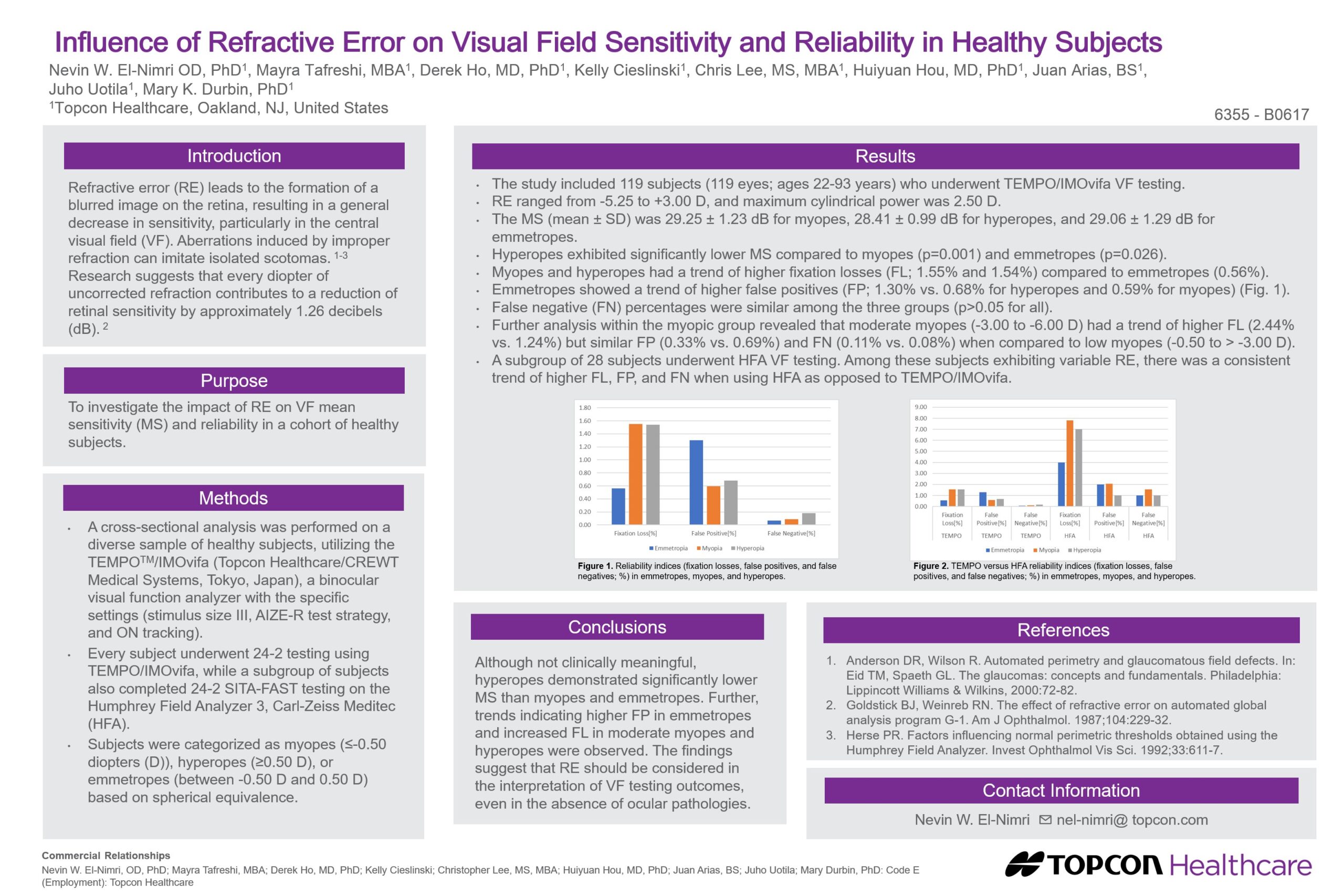ARVO 2024 Cross-sectional Study on TEMPO Binocular Perimeter
Introduction
As part of our ongoing commitment to advancing scientific knowledge and showcasing our exceptional team, we are proud to present our latest research series. Our presence at ARVO underscores our dedication to science, and this series highlights the groundbreaking work being conducted by our stellar employees.
This study investigates the impact of refractive error (RE) on visual field (VF) mean sensitivity (MS) and reliability in healthy subjects. Using the TEMPO/IMOvifa binocular visual function analyzer, 119 subjects aged 22-93 years were categorized based on their refractive status as myopes, hyperopes, or emmetropes. Results indicated that hyperopes had significantly lower MS compared to myopes and emmetropes, with myopes showing a trend of higher fixation losses (FL) and emmetropes displaying more false positives (FP). False negatives (FN) were similar across groups. These findings highlight the importance of considering RE in VF test interpretations, even in the absence of ocular diseases.
Abstract Poster

Click image above to enlarge or view abstract on ARVO Website.
Purpose of the Research
This research aims to investigate the impact of refractive error (RE) on visual field (VF) mean sensitivity (MS) and reliability in a cohort of healthy subjects. By analyzing these variations, the study seeks to enhance the understanding of how different refractive conditions affect VF testing outcomes.
Improving Patient Outcomes
This research provides valuable insights into how refractive errors influence visual field sensitivity and reliability, potentially leading to more accurate visual field test interpretations. By accounting for the effects of refractive error, clinicians can offer better-informed diagnoses and tailored treatment plans, ultimately improving the quality of eye care. This aligns with Topcon’s commitment to advancing eye health through innovative research and technology, ensuring precise and effective solutions for patients.
Meet the author: Nevin W. El-Nimri, OD, PhD

Nevin W. El-Nimri, OD, PhD., is a distinguished researcher in the field of ophthalmology, currently contributing her expertise at Topcon Healthcare. Dr. El-Nimri holds a doctorate in Vision Science and has dedicated her career to exploring the intricacies of visual function and eye health. At Topcon, Dr. El-Nimri is committed to pioneering research that bridges the gap between clinical practice and cutting-edge technology, ensuring that healthcare professionals have access to the most accurate and reliable diagnostic information. Her dedication to innovation and excellence underscores Topcon’s mission to enhance vision care and improve patient lives through scientific advancement.
Influence of Refractive Error on Visual Field Sensitivity and Reliability in Healthy Subjects
Authors: Nevin W. El-Nimri, Mayra Tafreshi, Derek Ho, Kelly Cieslinski, Christopher Lee, Huiyuan Hou, Juan D. Arias, Juho Uotila, Mary Durbin
Purpose: To investigate the impact of refractive error (RE) on visual field (VF) mean sensitivity (MS) and reliability in a cohort of healthy subjects.
Methods: A cross-sectional analysis was performed on a diverse sample of healthy subjects, utilizing the TEMPO/IMOvifa (Topcon Healthcare/CREWT Medical Systems, Tokyo, Japan), a binocular visual function analyzer with the specific settings (stimulus size III, AIZE-R test strategy, and ON tracking). Every subject underwent 24-2 testing using TEMPO/IMOvifa, while a subgroup of subjects also completed 24-2 SITA-FAST testing on the Humphrey Field Analyzer, Carl-Zeiss Meditec (HFA). Subjects were categorized as myopes (≤-0.50 diopters (D)), hyperopes (≥0.50 D), or emmetropes (between -0.50 D and 0.50 D) based on spherical equivalence.
Results: The study included 119 subjects (119 eyes; ages 22-93 years) who underwent TEMPO/IMOvifa VF testing. RE ranged from -5.25 to +3.00 D and maximum cylindrical power was 2.50 D. The MS (mean ± SD) was 29.25 ± 1.23 decibels (dB) for myopes, 28.41 ± 0.99 dB for hyperopes, and 29.06 ± 1.29 dB for emmetropes. Hyperopes exhibited significantly lower MS compared to myopes (p=0.001) and emmetropes (p=0.026). Myopes had a trend of higher fixation losses (FL; 1.55%) compared to emmetropes (0.58%) and hyperopes (1.46%). Emmetropes showed a trend of higher false positives (FP; 1.35% vs. 0.71% for hyperopes and 0.59% for myopes). False negative (FN) percentages were similar among the three groups (p>0.05 for all). Further analysis within the myopic group revealed that moderate myopes (-3.00 to -6.00 D) had a trend of higher FL (2.44% vs. 1.24%) but similar FP (0.33% vs. 0.69%) and FN (0.11% vs. 0.08%) when compared to low myopes (-0.50 to > -3.00 D). A subgroup of 23 subjects underwent HFA VF testing. Among these subjects exhibiting variable RE, there was a consistent trend of higher FL, FP, and FN when using HFA as opposed to TEMPO/IMOvifa.
Conclusions: Although not clinically meaningful, hyperopes demonstrated significantly lower MS than myopes and emmetropes. Further, trends indicating higher FP in emmetropes and increased FL in moderate myopes were observed. These findings suggest that RE should be considered in the interpretation of VF testing outcomes, even in the absence of ocular pathologies.
This abstract was presented at the 2024 ARVO Annual Meeting, held in Seattle, WA, May 5-9, 2024.
Link to abstract on ARVO Website.




